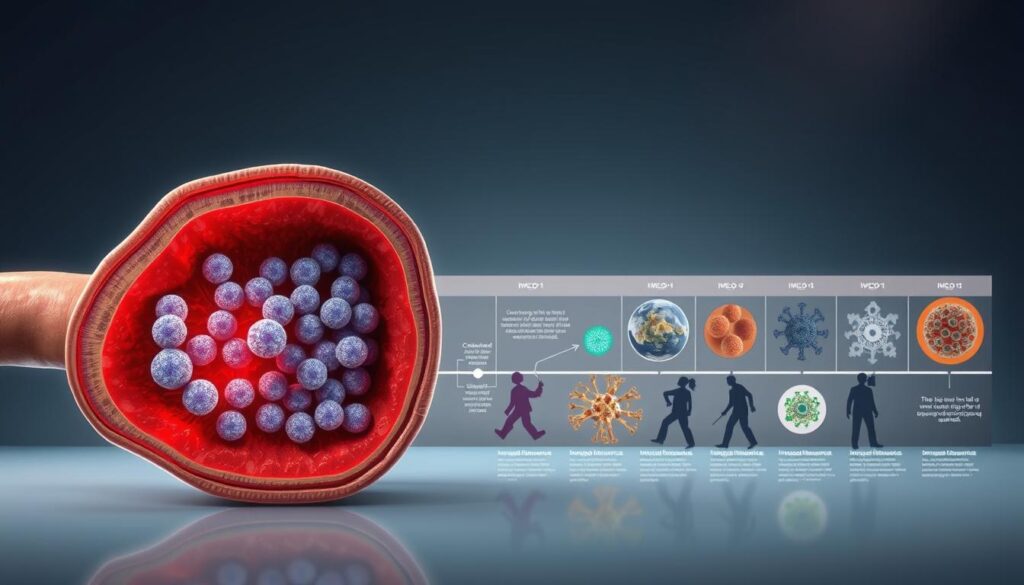Last Updated on November 3, 2025 by mcelik

We are seeing big changes in how we treat Acute Myeloid Leukemia (AML). New treatments are coming out to help patients more. At Liv Hospital, we focus on giving our patients the best and most tailored care with the latest AML medical advances.
New drugs like venetoclax and quizartinib are changing AML treatment for the better. These breakthroughs are bringing new hope and better results for those with this tough disease.

Acute myeloid leukemia (AML) is a fast-growing cancer that affects the blood and bone marrow. It’s a complex disease where abnormal white blood cells grow quickly in the bone marrow. This stops normal blood cells from being made.
AML is very aggressive and needs quick treatment. It messes up blood cell production, causing anemia, infections, and bleeding. Understanding AML’s aggressive nature is key to finding good treatments.
AML is a big part of leukemia cases in the U.S. Here are some important facts:
Some groups are more likely to get AML, like older adults and those with certain genes or past exposure to harmful substances. Spotting these high-risk groups early is vital for treatment.

In the last few decades, treatment of myeloid leukemia has changed a lot. It moved from broad treatments to more focused and effective ones. This change shows we now understand the disease better and have new ways to treat it.
Old treatments for acute myeloid leukemia were mostly chemotherapy and stem cell transplants. These methods worked sometimes but had big side effects. They didn’t always cure the disease.
Chemotherapy tried to kill fast-growing cells, like leukemia. But it also hurt other fast-growing cells, causing problems.
The world of AML leukemia treatments has changed a lot. Now, we have targeted and immunotherapies. These new methods focus on the disease’s specific parts, making treatments more precise and less harmful.
Targeted therapies, for example, can find and attack cancer cells without hurting healthy ones. This is a big improvement.
We measure how well treatment for acute myelogenous leukemia works by looking at patient outcomes. These include how long patients live, how well they respond to treatment, and their quality of life. Thanks to new therapies, more patients are living longer and feeling better.
Looking back and seeing where we are now with AML treatment shows how far we’ve come. New treatments keep coming, giving us hope for even better results.
The treatment for Acute Myeloid Leukemia (AML) is changing fast. New FDA-approved therapies are making a big difference. They are helping patients live longer and changing how doctors treat AML.
Venetoclax is a key drug in fighting AML. It works by stopping a protein in leukemia cells from growing. Studies show it works well, improving survival rates when used with other drugs.
Quizartinib targets a specific mutation in AML cells. It’s a big step forward in treating AML. Patients with this mutation are seeing better results, thanks to quizartinib.
Ziftomenib is another hopeful drug for AML. It’s part of a growing list of new treatments. These drugs are changing how we treat AML.
Studies confirm that venetoclax and quizartinib work well in real life. They help many patients. Here are some key findings from recent studies.
| Therapy | Patient Population | Outcome |
|---|---|---|
| Venetoclax + HMA | Newly diagnosed AML | Improved OS |
| Quizartinib | FLT3-ITD positive AML | Enhanced CR rates |
| Ziftomenib | NPM1 mutant AML | Promising ORR |
These new treatments are making a big difference in AML care. For more on these treatments, including stem cell therapy, check out Liv Hospital’s page on stem cell treatments for blood disorders
Targeted therapies are changing how we treat AML, bringing new hope for better results. We’re seeing a big change in how we manage Acute Myeloid Leukemia (AML). Targeted therapies are now a key part of treatment plans.
Molecular profiling is key for finding specific genetic changes in AML patients. This lets us create treatments that really target the disease’s causes. By knowing the genetic makeup of a patient’s leukemia, we can make treatments that fit their needs.
Molecular profiling involves:
Mutation-specific therapies aim to target the genetic changes that cause AML. This focus on specific mutations helps us create more effective treatments.
One big challenge in AML treatment is finding ways to beat resistance to therapy. Researchers are looking into new ways, like combining different treatments and using new drugs.
| Therapeutic Approach | Target | Benefit |
|---|---|---|
| Venetoclax | BCL-2 inhibition | Improved response rates |
| Quizartinib | FLT3 inhibition | Enhanced efficacy in FLT3-mutated AML |
| Ziftomenib | Menin-KMT2A inhibition | Novel mechanism for treating AML |
As we keep improving targeted therapies, the future looks brighter for AML patients. By using molecular profiling and focusing on specific mutations, we’re getting closer to treatments that really work for each patient.
Medical research is changing AML treatment in 2025. We’re moving towards more personalized and effective treatments for acute myeloid leukemia patients.
Risk-adapted treatment is key in AML management. Tailoring treatment to individual patient risk profiles leads to better disease management and outcomes. This method looks at genetic mutations, patient age, and overall health.
Improving drug combinations is vital for AML treatment. Combining targeted therapies with traditional chemotherapy has shown great results in trials. We’re also exploring new combinations, including immunotherapies.
Treatment algorithms are being developed based on patient characteristics. These algorithms help clinicians make informed decisions about the best treatment for each patient. By considering many factors, we can offer more effective and personalized care.
In conclusion, myeloid leukemia treatment in 2025 focuses on personalized, risk-adapted care. By using the latest research and technology, we’re improving the lives of AML patients.
As we move forward in treating acute myeloid leukemia (AML), more care is happening at home. This change is thanks to oral medications. These allow patients to take their treatment at home.
Oral medications have changed how AML is treated. They let patients manage their treatment at home, without needing to go to the hospital all the time. Venetoclax is one such medication. It targets cancer cells and has shown great promise.
Home-based care has greatly improved AML patients’ lives. It lets them keep up with their daily routines and spend more time with family. This boosts their mental health and helps them get a more complete care experience.
For home-based treatment to work, strong support systems are key. These include regular check-ups, counseling, and educational resources.
With these systems in place, AML patients can be more involved in their care. This leads to better treatment results and a better quality of life.
Immunotherapy is making AML treatment more personalized and effective. It uses the immune system to fight cancer. This approach is showing promise in treating Acute Myelogenous Leukemia.
CAR-T cell therapy is a big step forward in AML treatment. It takes a patient’s T cells, changes them to attack leukemia, and then puts them back in. Early trials have shown great results, with some patients going into complete remission.
Immune checkpoint inhibitors are also being tested for AML. They help the immune system attack cancer cells more effectively. Research is ongoing to find the best combinations and who will benefit most.
Bispecific antibodies are showing promise too. They can bind to both AML cells and T cells, helping to destroy them. Other new methods, like vaccines and oncolytic viruses, are being looked at to boost the immune response against leukemia.
The future of AML treatment looks bright. It will likely combine immunotherapies with targeted therapies and chemotherapy. As research keeps moving forward, we’re hopeful for better outcomes for AML patients.
Researchers are working hard to find a cure for Acute Myeloid Leukemia (AML). They are looking into gene editing and stem cell methods. These new technologies give hope to patients and doctors.
CRISPR-Cas9 gene editing is a big help in fighting AML. It can change the genome in precise ways. This could remove the genetic problems that cause AML.
Scientists are studying how CRISPR can fix genes that lead to leukemia. This could lead to long-term remission for patients.
Stem cell transplants are key in treating AML, mainly for those with high-risk disease. New techniques in stem cell transplants have made treatments better. This includes better matching and new ways to prepare patients.
Also, new sources of stem cells are being found. This means more people can get this life-saving treatment.
Gene editing and stem cell therapies could lead to long-term remission and even a cure for AML. These methods could make treatments more effective and targeted. This would greatly improve patient outcomes and quality of life.
As research keeps moving forward, we are hopeful. We believe these new approaches will change how AML is treated.
Medical technology is advancing fast, making personalized medicine key in treating myeloid leukemia. Now, we can tailor treatments to fit each patient’s needs. This has greatly improved results for those with Acute Myeloid Leukemia (AML).
Genomic and proteomic profiling lead the way in AML treatment. We look at a patient’s genes and proteins to find the leukemia’s cause. This lets us pick treatments that work best for each person.
AML has many molecular mutations, each affecting treatment differently. We adjust treatments based on these mutations. For example, FLT3 inhibitors help those with FLT3 mutations, and IDH inhibitors work for IDH1 or IDH2 mutations.
Artificial Intelligence (AI) is changing AML care by helping choose treatments. AI looks at genetic data, clinical info, and treatment results to suggest the best therapy. This AI method makes AML treatment more precise and effective.
Personalized medicine is leading us to a future where AML treatment is more effective and tailored. This approach is very promising for better outcomes and quality of life for those with this tough disease.
Managing relapse and refractory AML needs a mix of new therapies and advanced tests. We tackle these tough cases with a detailed plan. Our goal is to give the best care possible.
New treatments for AML are showing great promise. Venetoclax is being used with other drugs for tough cases. Quizartinib and other FLT3 inhibitors are also being tested for relapse.
We’re moving towards treatments that fit each patient’s unique genetic makeup. This personalized approach helps us tackle resistance better and boost success rates.
Tracking minimal residual disease (MRD) is key in AML, even more so in relapse and refractory cases. New tools like next-generation sequencing (NGS) and digital PCR help us spot and measure MRD accurately. This info is key for fine-tuning treatments and better results.
| Technology | Application in AML | Benefits |
|---|---|---|
| Next-Generation Sequencing (NGS) | Deep sequencing for mutation detection | High sensitivity, complete genomic analysis |
| Digital PCR | Quantifying specific mutations | High precision, sensitive MRD detection |
At Liv Hospital, we’re all about creating new ways to handle relapse and refractory AML. Our team works with patients to craft treatment plans that use the latest in AML care.
“The key to addressing relapse and refractory AML lies in a complete approach that combines new therapies with advanced diagnostic techniques.”
Liv Hospital’s Medical Team
With these new methods, we’re ready to tackle the tough cases of relapse and refractory AML. We aim to give our patients the best chances for success.
The world of acute myeloid leukemia treatment is changing fast. New ways to target cancer cells, like immunotherapies and gene editing, are making treatments better.
New drugs like venetoclax and quizartinib are bringing hope to those with AML. They offer a chance for better treatment. Also, using DNA tests to tailor treatments is making care more personal and effective.
Research is getting closer to finding a cure for AML. Gene editing and stem cell transplants are showing great promise. Even though there’s more to do, the outlook for AML treatment is very positive.
AML is a fast-growing blood and bone cancer. It messes with how blood cells are made. This can lead to serious health problems.
New treatments include targeted therapies and immunotherapies. Gene editing is also being explored. These advancements have greatly improved treatment results and patient life quality.
Molecular profiling helps tailor treatments. It finds specific genetic changes. This makes treatments more effective and targeted.
Venetoclax is a groundbreaking drug. It has shown great results in AML patients. It works best when combined with other treatments.
Yes, thanks to oral medications and ambulatory treatments. Many AML patients can now get treatment at home. This improves their life quality.
CAR-T cell therapy is a type of immunotherapy. It genetically modifies T cells to attack cancer cells. It shows promise in treating AML, mainly in patients with relapsed or refractory disease.
Liv Hospital uses new and innovative treatments. They have risk-adapted strategies and novel methods for resistant AML. This provides complete care for AML patients.
Gene editing, like CRISPR, could lead to long-term remission or even cure AML. It precisely targets genetic mutations.
Personalized medicine uses genomic and proteomic profiling. It tailors treatments to each patient. This leads to more effective and targeted therapies.
Risk-adapted strategies tailor treatments to each patient’s risk level. This improves outcomes and reduces side effects.
Immunotherapy in AML is rapidly growing. It includes CAR-T cell therapy, immune checkpoint inhibitors, and bispecific antibodies. These show promise in bettering patient outcomes.
Subscribe to our e-newsletter to stay informed about the latest innovations in the world of health and exclusive offers!
WhatsApp us